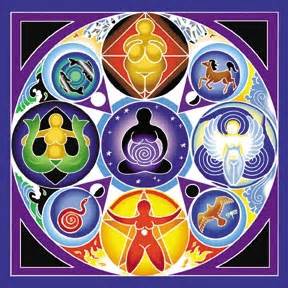 For the Active Type
For the Active Type
The “Four Paths of Yoga” fit different temperaments of spiritual aspirants.
The active type will have little patience for the lofty philosophical teachings and ponderings of Jnana Yoga and find little practical application in it. Again his or her interest in devotion and psychology will be fairly mild. His or her main concern will be to act and practice a sadhana (path) that will directly benefit the world at large.
Selfless Service
“Thy right is to work only; but never with its fruits; let not the fruit of the action be thy motive, nor let thy attachment be to inaction.” Bhagavan Sri Krishna, Bhag. Gita – II.47
Most of all, Karma Yoga is a yoga of purification. Purification of the heart, purification of the mind. Owing to avidya, the original spiritual ignorance, we are affected by egoism and selfishness. In the normal state of consciousness, all our actions are driven by a selfish motive. The performance of these actions further increases our selfishness and ignorance, and the causes of our bondage.
 Practicing Karma Yoga is developing selflessness by performing actions without any expectations of any rewards or results of any kind.
Practicing Karma Yoga is developing selflessness by performing actions without any expectations of any rewards or results of any kind.
Usually the fruit of our actions come to us in many ways: monetary compensation, public recognition, a photo in a newspaper or newsletter, a thank you, a nod and much more. The karma yogi watches his/her mind in order to see whether he/she experiences any elation or disappointment in the presence or absence of the above. There are different bhavas that one can use to achieve this.
For example you can picture yourself as being a servant of the Divine One being on this plane just to do service. This is the servant bhava or instrument bhava.
You can mix Karma Yoga and Bhakti Yoga by doing all actions as an expression of your love for the Lord. A modern day karma yogini master was Mother Teresa who called her work “love in action”. As we say in yoga: “work is worship”.
The karma yogi can also use the sakshi bhava of Jnana Yoga, feeling that he/she is the silent witness of actions, being totally detached from the play of maya and the functions of his/her instruments, the karma indriyas (sense organs of action).
Any task can become Karma Yoga. It just takes a lot of awareness. It is important to know that one’s mind is very clever and has many tricks to divert us from reaching the goal. Most aspirants will fail to detect the subtle traps of their own minds. Therefore, it is highly recommended to dedicate a certain amount of time performing volunteer work. This will provide a better ground for spiritual progress. Enough practice will make one more capable of applying these teachings in everyday actions.
Any contribution to your community will be favorable to this yoga: help the homeless, the sick, participate in local community events, assist your neighbor, help someone cross the street, the examples are countless.
 As good as these are, the service of one’s guru under his or her guidance is even superior in its benefits. Karma Yoga done with the spirit of service, respect and devotion will help draw upon the aspirant guru kripa (grace of the guru).
As good as these are, the service of one’s guru under his or her guidance is even superior in its benefits. Karma Yoga done with the spirit of service, respect and devotion will help draw upon the aspirant guru kripa (grace of the guru).
If you don’t know a live master, service to your community yoga teacher is the next best thing. This may help you connect to the guru parampara, the lineage of masters who came before him or her.
Most ashrams offer the opportunity to their students to perform seva (service). The Shakti-Shiva Ashrama is no different. You may want to offer your services to our ashram. If so please contact us.